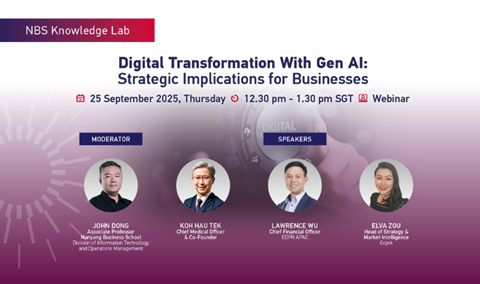The Science Behind Pay-for-Performance for Managers: An NBS Alumni Continuous Learning Masterclass in Manila
The speaker delved into the intricacies, controversies, and impact of Pay-for-Performance (PFP) systems, a popular compensation model linking employee pay with performance, during a masterclass held on 14 November 2023 in Manila. This event, curated specifically for NBS Alumni residing in the Philippines, was conducted by Professor Jason Shaw, the Shaw Foundation Chair in Business from NBS.
The following is an edited transcript:
Global shift towards PFP systems
There is a notable shift towards PFP systems, even in countries such as Finland, where historically, pay has been seniority-based and nearly all employees are unionised. Further, surveys indicate that two-thirds of Asian countries and organisations believe that PFP systems effectively motivate employees to enhance productivity.
The controversy surrounding PFP systems
Nevertheless, controversy surrounds PFP systems especially in cases where top executives receive exceedingly huge bonuses.
Many authors also speak against its effectiveness. Drawing upon the principles of Self-Determination Theory (SDT), opponents of PFP systems argue that internalised motivations are associated with more positive outcomes such as job satisfaction, performance, and proactivity than externalised motivations. Some even go as far as arguing that offering extrinsic rewards erodes one’s intrinsic interest and the model only works for mundane tasks where there is no intrinsic interest.
However, research findings say otherwise, as there is a correlation between financial incentives and performance, even for interesting tasks. This clearly shows that financial incentives do work within a reasonable range. Further studies using meta-analysis support this conclusion, showing a slightly positive relationship between financial incentives and individual performance.
Sweet spot of PFP systems
While we recognise the correlation between PFP systems and performance, this is not a linear relationship. At low levels of reward size, the common reaction is apathy. Just-noticeable difference (JND) analysis suggests that it takes a certain extent of change before the reward size becomes noticeable. Studies suggest that the sweet spot or JND point for PFP systems is about 5 to 7 percent of annual base pay as a minimum threshold. The relationship weakens as incentives get larger, as a 30-percent pay increase does not yield a corresponding one third increase in effort, performance, and quality. In general, incentives contribute to approximately 10 percent of the variation in future performance.
Perception of control in PFP systems
Employees tend to perform better when they believe they are in control. Prof Shaw shared the example of United Airlines attempting to replace the employee bonus plan with a lottery system where only random employees were picked to receive bonuses. The plan met with intense opposition and was never implemented.
Research shows that our reactions are muted even when we receive less than expected, especially when there is a low perception of control. When the appraisal system is perceived as biased, individuals are likely to feel ambivalent about a negative review but will experience euphoria over a positive one. However, despair sets in after this euphoria, as individuals perceive the lack of control and the unlikelihood of a recurrence.
On the contrary, the reaction will be intensely negative if one receives less than expected when there is a high perception of control.
Fairness in PFP systems
Incentives work best when expectations are carefully managed and effectively facilitated by a fair system. With a reasonable system that rewards the right performance criteria and is clearly communicated, there will be increases in effort and performance.
Managing perceptions of fairness in compensation is critical as employees need to believe they can control their outcomes in a fair manner. When there is procedural fairness in a PFP system, employee reactions will be more positive.
Q & A Segment
Importance of flexible benefit systems
In response to a question on how non-financial benefits correlate with performance, Prof Shaw shared that in general, incentives such as sick leave and leave support for further education can be effective as there will be situations when such incentives are as important as — if not more than — financial rewards.
Effect of wide income gaps on motivation
In response to a question on how the huge pay packages of senior executives affect the motivation of the lower-income working class, Prof Shaw acknowledged that the wide gaps are societal and cultural issues with negative implications. However, such comparisons do not necessarily affect the motivation of the man on the street. Comparisons within their own work group would matter more in people's day-to-day lives.
PFP systems are effective as there is a correlation between financial incentives and performance. They work best when employees perceive a sense of control over their appraisal outcome in a fair system that rewards them for good performances.
Watch the masterclass here:


.tmb-listing.png?Culture=en&sfvrsn=d48abb4_1)




